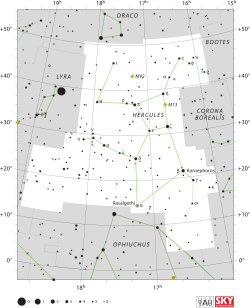Omicron Herculis
This article needs additional citations for verification. (May 2012) |
| Observation data Epoch J2000 Equinox J2000 | |
|---|---|
| Constellation | Hercules |
| Right ascension | 18h 07m 32.55073s[1] |
| Declination | +28° 45′ 44.9679″[1] |
| Apparent magnitude (V) | 3.83[2] |
| Characteristics | |
| Spectral type | B9.5 V[3] |
| U−B color index | –0.07[2] |
| B−V color index | –0.02[2] |
| Variable type | γ Cas |
| Astrometry | |
| Radial velocity (Rv) | –29.5[4] km/s |
| Proper motion (μ) | RA: –0.02[1] mas/yr Dec.: +8.55[1] mas/yr |
| Parallax (π) | 9.65 ± 0.16 mas[1] |
| Distance | 338 ± 6 ly (104 ± 2 pc) |
| Details | |
| Rotational velocity (v sin i) | 194[5] km/s |
| Other designations | |
Omicron Herculis (o Her, o Herculis) is a multiple star system in the constellation Hercules. It used to be called Masym ("the wrist"), but this name was transferred to Lambda Herculis.[6]
Properties
Omicron Herculis is a B9.5V star approximately 106 pc from the Earth. It has an apparent magnitude of 3.83, and an absolute magnitude of -1.29. The star burns bluish-white, and has a luminosity approximately 180x as bright as the Sun. Omicron Herculis is 3.32 solar masses.
Omicron Herculis is an eruptive variable of the Gamma Cassiopeia class, which are rapidly rotating B-class stars with mass outflow.
Omicron Herculis is both a spectroscopic and an interferometric binary star with a separation of 0.1 arcsec.
Omicron Hercules is notable for residing close to the coordinates of the solar apex, the direction towards which the Sun is moving. This was first noticed by William Herschel in 1783,[7] although in his first calculation he identified this point with Lambda Herculis.[8] It will eventually become the brightest star in the sky in approximately 3 million years from today, at -0.4, slightly less bright than Canopus today.
See also
- Lists of stars in the constellation Hercules
- Spectral type B
References
- ^ a b c d e van Leeuwen, F. (November 2007), "Validation of the new Hipparcos reduction", Astronomy and Astrophysics, 474 (2): 653–664, arXiv:0708.1752, Bibcode:2007A&A...474..653V, doi:10.1051/0004-6361:20078357.
- ^ a b c Johnson, H. L.; et al. (1966), "UBVRIJKL photometry of the bright stars", Communications of the Lunar and Planetary Laboratory, 4 (99), Bibcode:1966CoLPL...4...99J.
- ^ Cowley, A.; et al. (April 1969), "A study of the bright A stars. I. A catalogue of spectral classifications", Astronomical Journal, 74: 375–406, Bibcode:1969AJ.....74..375C, doi:10.1086/110819
- ^ Wilson, Ralph Elmer (1953), General Catalogue of Stellar Radial Velocities, Washington: Carnegie Institution of Washington, Bibcode:1953GCRV..C......0W.
- ^ Royer, F.; Zorec, J.; Gómez, A. E. (February 2007), "Rotational velocities of A-type stars. III. Velocity distributions", Astronomy and Astrophysics, 463 (2): 671–682, arXiv:astro-ph/0610785, Bibcode:2007A&A...463..671R, doi:10.1051/0004-6361:20065224.
- ^ Kaler, Jim. "Omicron Herculis". Retrieved 2016-05-13.
- ^ Lankford, John (1997). History of astronomy: an encyclopedia. Garland encyclopedias in the history of science. Vol. 1. Taylor & Francis. p. 258. ISBN 0-8153-0322-X.
- ^ Herschel, William (1783). "On the Proper Motion of the Sun and Solar System; With an Account of Several Changes That Have Happened among the Fixed Stars since the Time of Mr. Flamstead". Philosophical Transactions of the Royal Society of London. 73: 247–83. JSTOR 106492.

